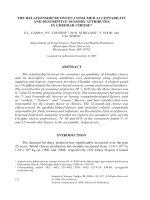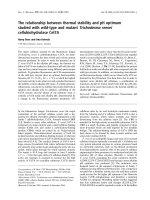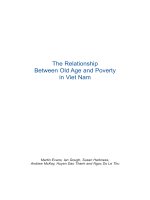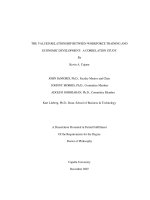The relationship between default risk and interest rates: An empirical study research insight
Bạn đang xem bản rút gọn của tài liệu. Xem và tải ngay bản đầy đủ của tài liệu tại đây (211.73 KB, 17 trang )
OCTOBER 2, 2009
THE RELATIONSHIP BETWEEN DEFAULT
RISK AND INTEREST RATES: AN EMPIRICAL
STUDY
RESEARCH INSIGHT
ABSTRACT
Understanding the relationship between credit and interest rate risk is critical to many
applications in finance, from valuation of credit and interest rate-sensitive instruments to risk
management. This study empirically examines the relationship between interest rates and
default risk using firm level corporate default data in the United States between 1982 and
2008.
We find significant negative contemporaneous correlations between the changes in short
interest rates and aggregate default rates, with a particularly strong relationship around
financial crises. We also explore the explanatory power of interest rate variables in predicting
default when conditioned on Moody’s KMV EDF™ credit measures. In addition, we study
the impact of changes in short rates, expected changes in short rates, interest rate slopes, and
unexpected changes in short rates. Conditional on the EDF credit measure, interest rates and
default were not found to have any statistically significant correlation. Our findings have a
number of important implications for risk measurement and management.
AUTHORS
Andrew Kaplin
Amnon Levy
Shisheng Qu
Danni Wang
Yashan Wang
Jing Zhang
Copyright © 2009, Moody’s Analytics, Inc. All rights reserved. Credit Monitor, CreditEdge, CreditEdge Plus,
CreditMark, DealAnalyzer, EDFCalc, Private Firm Model, Portfolio Preprocessor, GCorr, the Moody’s logo, the
Moody’s KMV logo, Moody’s Financial Analyst, Moody’s KMV LossCalc, Moody’s KMV Portfolio Manager,
Moody’s Risk Advisor, Moody’s KMV RiskCalc, RiskAnalyst, RiskFrontier, Expected Default Frequency, and EDF are
trademarks or registered trademarks owned by MIS Quality Management Corp. and used under license by
Moody’s Analytics, Inc.
ACKNOWLEDGEMENTS
We are grateful to our MKMV Research colleagues for their generous comments. All remaining errors are, of course, our
own.
Published by:
Moody’s KMV Company
To contact Moody’s KMV, visit us online at
www.moodyskmv.com. You can also contact Moody’s KMV through
e-mail at , or call us by using the following phone numbers:
NORTH AND SOUTH AMERICA, NEW ZEALAND, AND AUSTRALIA:
1 866 321 MKMV (6568) or 415 874 6000
EUROPE, THE MIDDLE EAST, AFRICA, AND INDIA:
44 20 7280 8300
ASIA-PACIFIC:
852 3551 3000
JAPAN:
81 3 5408 4250
TABLE OF CONTENTS
THE RELATIONSHIP BETWEEN DEFAULT RISK AND INTEREST RATES: AN EMPIRICAL STUDY 3
1 INTRODUCTION .................................................................................................. 5
2 LITERATURE REVIEW......................................................................................... 6
3 DATA AND VARIABLE DESCRIPTION .................................................................. 7
4 THE RELATIONSHIP BETWEEN INTEREST RATES AND AGGREGATE DEFAULT
RATES .............................................................................................................. 11
4.1
Contemporaneous Correlations ............................................................................. 11
4.2
Corr(Δr, DR) Over Time ........................................................................................... 12
5 CONDITIONAL CORRELATION ANALYSIS USING FIRM-LEVEL DATA................ 12
5.1
Predictive Logistic Regression Model at Firm Level ............................................. 12
5.2
Contemporaneous Logistic Regression Model at Firm Level ............................... 13
6 CONCLUSION.................................................................................................... 14
APPENDIX A SIMULATION PROCEDURE FOR CALCULATING SE( )................... 15
2
ˆ
β
1 INTRODUCTION
Credit and interest rate risks are among the most important risks faced by financial institutions. It is well known that the
two risks are economically related, and understanding their relationship is important to many applications in finance.
For example, the values of callable corporate bonds of fixed coupons depend on both the interest rate dynamics and the
issuers’ credit qualities. Alternatively, financial institutions’ balance sheets include both credit and interest rate-sensitive
instruments. If interest rates (or credit quality) change unexpectedly, the resulting impact on credit quality (or interest
rates) will help determine how the assets and liabilities line up, consequently determining the institution’s financial
health. Thus, the relationship between credit and interest rate risks plays an important role in both pricing instruments
whose values are sensitive to both risks, as well as in managing an institution’s balance sheet.
Despite its importance, the exact nature of the relationship between credit and interest rate risk is not quite clear. For
example, consider the relationship between default and interest rate. If the economy is in recession and the default rate is
high, interest rates are often relatively low through the traditional central bank monetary policy of lowering rates in the
hope of stimulating the economy. When the economy improves, the central bank tends to raise rates. Given that
government rates often form the basis of the cost of capital faced by the companies, when the interest rates increase, a
firm must generate a higher rate of return on its assets to stay in business. If the cost of capital is higher than the rate of
return for a particular company, that firm will run into financial insolvency or bankruptcy. In other words, the central
bank is raising rates in an effort to slow the economy. Therefore, we may conjecture that the relationship between default
risk and interest rates is sensitive to some measure of where the economy is in the business cycle and/or other
macroeconomic factors. Moreover, co-movements between interest rates and default risk may exhibit different behavior
whether analyzed contemporaneously or in a causal or predictive setting.
Given the potential ambiguity in intuition cited above, the main goal of this study is to analyze the empirical relationship
between interest rates and default risk. Moreover, the structure of the analysis focuses on understanding the dynamics
within the context of risk management. While we ultimately want to understand the relationship between credit risk,
including the risk of default, migration and recovery, and interest rates. Toward this goal, we analyze the relationship
between interest rates and default rates using the Moody’s KMV public firm default database—the largest existing
database of its kind. We consider both contemporaneous and predictive relationships. The predictive relationship focuses
on the following question: Do interest rates provide information beyond Moody’s KMV EDF
™
(Expected Default
Frequency) credit measures that can be used in predicting default? The contemporaneous analysis provides insights into
whether the correlation between interest rates and defaults should be modeled when measuring portfolio economic
capital. Specifically, we ask the following question: If we condition on the current term structure of interest rates, as well
as on EDF credit measures, would the conditional distribution of future interest rates and defaults be correlated? In both
cases we find no correlation between defaults and interest rates after conditioning on EDF credit measures.
It is worth noting the differences between our study and the existing literature. Most of the related academic literature
studies the relationship between credit spreads and interest rate. The papers addressing the relationship between default
and interest rates are relatively scarce and results can be contradictory. For example, Fridson et al. (1997) reported that
on a quarterly basis during the period of 1971–1995, there was a moderate, significant positive correlation between
default rates and real interest rate, and a strong positive correlation between default rate and lagged 2-year real interest
rate. We find negative correlation between changes in interest rates and default rates, with the correlations between
changes in short rates and default rates being significantly negative. This result generally was consistent with findings on
the relationship between changes in credit spread and changes in interest rates documented in a few papers.
1
What is
different and unique with this study is that our dataset allows us to perform firm-level regressions to test the impacts of
interest rates on default conditional on EDF, whereas most previous analyses were performed at an aggregated level.
Our empirical findings have a number of important implications in practice. The results suggest that the interest rate and
default risk dynamics are more complicated than previously reported. From the perspective of comprehensive risk
modeling, this suggests that it is quite challenging, perhaps impossible, to specify a theoretical model that fully describes
both the interest rate and default processes in a correlated manner with a single correlation parameter. It may be more
constructive to develop default risk model that captures the dynamic impacts of interest rate separately, as in the case of
the Moody’s KMV EDF model. This also suggests that once an accurate credit risk measure such as EDF is properly
incorporated, interest rates and default risk become conditionally uncorrelated in the joint model, leading to a significant
1
See Longstaff and Schwartz (1995), Duffee (1998), and Collin-Dufresne et al. (2001).
THE RELATIONSHIP BETWEEN DEFAULT RISK AND INTEREST RATES: AN EMPIRICAL STUDY 5
decrease in computational complexity. From the perspective of managing both interest rate and default risk, our results
suggest that risk managers should be paying close attention to these dynamics, especially when hedging is involved.
This paper is organized in the following way.
•
Section 2 provides a review of the existing literature describing the relationship between credit and interest rate risk.
•
Section 3 discusses the data and variable specification.
•
Section 4 describes historical correlation findings using aggregated data.
•
Section 5 presents the results from regression specifications using granular data.
•
Section 6 provides concluding remarks.
2 LITERATURE REVIEW
Numerous studies have examined the relationship between credit and interest rate risk in various contexts, from derivate
pricing models and term structure modeling, to risk integration. Most studies focus on the relationship between credit
spreads and various interest rate variables.
As far as we know, Fridson et al. (1997) is the only study that exclusively focuses on the correlation between real interest
rate and default rate. Using Moody’s quarterly default rate on high-yield bonds from 1971–1995, they find a weak
positive correlation between default rate and nominal interest rates, a moderate positive correlation between default rates
and real interest rate, and a strong positive correlation between default rate and lagged 2-year real interest rate. They
argue that interest rate level is the basis of cost of capital. When the interest rate is high, the firm must generate higher
rate of return in order to survive. If the cost of capital is higher than the rate of return, the firm would run into financial
insolvency or bankruptcy. This indicates that there is a positive relationship between default rate and real interest rates.
Longstaff and Schwartz (1995) develop a simple approach to valuing risky corporate debt that incorporates both default
and interest rate risk, and test its empirical implications. Using the changes in the 30-year Treasury bond yield and the
changes in the bond yield using Moody’s corporate bond database from 1977–1992, they find negative correlation
between the two across combinations of industries and rating categories. For example, a 100 basis point increase in the
30-year Treasury yield reduces Baa-rated Utility industry credit spreads by 62.6 basis points.
Duffee (1998) studies the correlation between the changes in 3-month Treasury bill yield, the changes in term structure
slope (defined as the difference between 30-year and 3-month Treasury bond yields), and the changes in yield spread of
corporate bond with data from 1985–1995. The changes in yield spread are constructed monthly from non-callable
bonds rated from Aaa to Baa, maturities ranging from 2 to 30 years. He finds that an increase in T-bill yield corresponds
with a decline in yield spreads for each combination of maturity and credit rating. The relationship is stronger for longer-
maturity and for lower quality bonds. The relation between yield spreads and slope is generally negative, insignificant for
high quality bonds and significant for low quality bonds. Duffee also test the correlation between callable bonds and
interest rates using Moody’s and Lehman Brothers bond indices. Callable bonds show stronger negative correlations than
non-callable bonds.
Collin-Dufresne et al. (2001) study the determinants of the credit spread changes using data of straight bonds issued by
industrial firms in the Lehman Brother bond database from 1988–1997. The changes of credit spread are regressed over
the change in the 10-year Treasury bond yield, the change in slope (defined as the difference between 10-year and 2-year
Treasury bond yields), the convexity, the change in leverage, the change in asset volatility, the change in jump, the
liquidity, and the individual firm’s stock return. The regressions are performed for bonds in each unique combination of
maturity and rating category. They find significant negative correlations in the changes in interest rates, insignificant
negative correlations in the convexity, and insignificant negative correlations in the change in slope for bonds with longer
maturities, and insignificant positive correlations in the change in slope for bonds with shorter maturities.
Joutz et al. (2001) study the dynamics of corporate credit spreads by examining how default and systematic risk measures
influence corporate bond spreads for investment and non-investment grade corporate bonds over the 1987–1997 period.
The changes in credit spread are selected from Lehman Brothers bond indexes, or constructed from individual non-
callable bonds rated from AA to BBB and maturities ranging from intermediate to long-term. They find the relation
6









